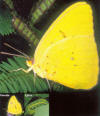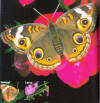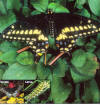Discover Florida Nature
It's time to explore the natural Florida


|
|
|
|
|
|
With the warm climate, butterflies are often in flight year round in
Florida. From the Giant Swallowtail to the Little Metalmark, the state
has a wealth of flittering, fluttering, flappers, and gliders
brightening the landscape. There are more than 17,000s different
species, or types, of butterflies. They come in many colors and live in
very different types of climates. In Florida over 180 different
butterflies have been recorded. Within that mix, some 40 are considered
either unique to the state or occur mostly within its boundaries All butterflies pass through a life cycle consisting of four developmental stages: egg, larva, pupa, and adult. All butterflies begin life as a small egg. Once the egg hatches the tiny larva begins feeding almost immediately, and they essentially live to eat! Once it finishes eating the larva seeks a safe place to pupate. At the appropriate time the pupa splits open and a beautiful butterfly emerges! Adult butterflies share several common characteristics, including six jointed legs, two compound eyes, two antennae, a hard exoskeleton, and three main body segments: the head, thorax, and abdomen. Along with moths, they comprise the Order Lepidoptera, a combination of Greek words meaning scale-winged. Their four wings, as well as body are typically covered with numerous tiny scales, Overlapping like shingles on a roof, they make up the color and pattern of a butterfly's wings. Butterflies and moths are closely related and often difficult to tell apart. Generally butterflies fly during the day, have large colorful wings that are held vertical over the back when at rest, and bear distinctly clubbed antennae. In contrast most moths are nocturnal. They are usually overall drabber in color and may often resemble dirty, hairy butterflies. At rest, moths tend to hold their wings to the sides, and have feathery or threadlike antennae. Butterflies are just one more living thing in the garden that brings happiness to young and old alike. For the older of us, they bring back sweet childhood memories. For the youngest of us, they encourage imagination and launch them into a ballet dance through the garden!  American
Painted Lady -American Painted Lady is most easily
distinguishable by its two large eyespots on the ventral side and also
uniquely features a white dot within the forewing subapical field, set
in pink on the underside and usually also in the dorsal side's orange
field. American Lady has a wing span of 1 3/4 - 2 5/8 inches. During the
afternoon, males perch on hilltops or on low vegetation if there are no
hills. Females lay eggs singly on the top of host plant leaves.
Caterpillars are solitary, living and feeding in a nest of leaves tied
with silk. Adults hibernate. American
Painted Lady -American Painted Lady is most easily
distinguishable by its two large eyespots on the ventral side and also
uniquely features a white dot within the forewing subapical field, set
in pink on the underside and usually also in the dorsal side's orange
field. American Lady has a wing span of 1 3/4 - 2 5/8 inches. During the
afternoon, males perch on hilltops or on low vegetation if there are no
hills. Females lay eggs singly on the top of host plant leaves.
Caterpillars are solitary, living and feeding in a nest of leaves tied
with silk. Adults hibernate.  Cloudless
Sulphur - The Cloudless sulphur is a large yellow butterfly
with a fast powerful flight. These bright yellow butterflies have a
wingspan of 2.2 - 2.8 inches. Abundant throughout the Southeast, it is a
common garden visitor and one of the most easily recognized butterflies
in Florida. Adult butterflies have extremely long proboscis and can feed
at many long, tubular flowers that are inaccessible to other
butterflies. in the fall there is a massive southward migration to
Florida of Cloudless Sulphurs. The annual event is one of Florida's most
impressive natural phenomena! Cloudless
Sulphur - The Cloudless sulphur is a large yellow butterfly
with a fast powerful flight. These bright yellow butterflies have a
wingspan of 2.2 - 2.8 inches. Abundant throughout the Southeast, it is a
common garden visitor and one of the most easily recognized butterflies
in Florida. Adult butterflies have extremely long proboscis and can feed
at many long, tubular flowers that are inaccessible to other
butterflies. in the fall there is a massive southward migration to
Florida of Cloudless Sulphurs. The annual event is one of Florida's most
impressive natural phenomena!  Common
Buckeye- The Common Buckeye is one of the most easily
identified butterflies. It large target shaped eyespots help deflect
predators away from its vulnerable body, and it has a wing span of
1.5-2.7 inches. The common Buckeye butterfly is fond of open, sunny
locations with low growing vegetation. Male Buckeyes establish
territories and actively investigate passing objects. This butterfly's
flight is rapid and low to the ground. Unable to withstand freezing
temperatures, the Common Buckeye annually undertakes a southward fall
migration and overwinters in warmer Gulf Coast locations including
Florida. Common
Buckeye- The Common Buckeye is one of the most easily
identified butterflies. It large target shaped eyespots help deflect
predators away from its vulnerable body, and it has a wing span of
1.5-2.7 inches. The common Buckeye butterfly is fond of open, sunny
locations with low growing vegetation. Male Buckeyes establish
territories and actively investigate passing objects. This butterfly's
flight is rapid and low to the ground. Unable to withstand freezing
temperatures, the Common Buckeye annually undertakes a southward fall
migration and overwinters in warmer Gulf Coast locations including
Florida.
 Black
Swallowtail- The Black Swallowtail is one of Florida's most
common garden butterflies. Its plump, green larvae, often referred to as
parsley worms, feed on many cultivated herbs, and may even become a
minor nuisance pest. With a wingspan of 2.5-4.2 inches, the Black
Swallowtail is equally at home along country roads, urban gardens, and
meadows. Male butterflies have a strong rapid flight and frequently
perch on low vegetation. Both sexes of the Black Swallowtail are
extremely fond of flowers and readily stop to feed on nectar. This
butterfly is one of six different species that mimic the toxic Pipevine
Swallowtail to gain protection from predators. Black
Swallowtail- The Black Swallowtail is one of Florida's most
common garden butterflies. Its plump, green larvae, often referred to as
parsley worms, feed on many cultivated herbs, and may even become a
minor nuisance pest. With a wingspan of 2.5-4.2 inches, the Black
Swallowtail is equally at home along country roads, urban gardens, and
meadows. Male butterflies have a strong rapid flight and frequently
perch on low vegetation. Both sexes of the Black Swallowtail are
extremely fond of flowers and readily stop to feed on nectar. This
butterfly is one of six different species that mimic the toxic Pipevine
Swallowtail to gain protection from predators. Giant
Swallowtail - Living up to its name the Giant Swallowtail is
Florida's largest butterfly with a wingspan of 4.5 - 5.5 inches. The
impressive adults are strong fliers but readily stop at colorful
flowering plants to feed and are regular garden visitors. When nectaring,
adult Giant Swallowtails continue to flutter their wings, much like a
hummingbird. This behavior, along with a long proboscis enables the
butterfly to visit a wide range of not easily reached flowers, including
flowers that may not be strong enough to support their weight. Giant
Swallowtail larvae are often called "orange dogs" because of their
fondness for citrus, and they occasionally become a pest in orange
orchards. Giant
Swallowtail - Living up to its name the Giant Swallowtail is
Florida's largest butterfly with a wingspan of 4.5 - 5.5 inches. The
impressive adults are strong fliers but readily stop at colorful
flowering plants to feed and are regular garden visitors. When nectaring,
adult Giant Swallowtails continue to flutter their wings, much like a
hummingbird. This behavior, along with a long proboscis enables the
butterfly to visit a wide range of not easily reached flowers, including
flowers that may not be strong enough to support their weight. Giant
Swallowtail larvae are often called "orange dogs" because of their
fondness for citrus, and they occasionally become a pest in orange
orchards. Zebra
Longwing
- The Zebra Longwing is the state butterfly of Florida! Aptly named this
butterfly is quickly recognized by the yellow-white stripes, extremely
elongated wings, and wingspan of 2.9 - 3.5 inches. The Zebra Longwing
rarely spends long periods of time in open, sunny locations, but is
seen often in shady gardens and lawns. Adult Zebra Longwings have a slow
elegant flight and are able to maneuver gracefully through dense
vegetation. A tropical butterfly, the Zebra Longwing cannot tolerate
prolonged exposure to freezing temperatures. Adults are extremely long
lived and may survive for several months. Zebra
Longwing
- The Zebra Longwing is the state butterfly of Florida! Aptly named this
butterfly is quickly recognized by the yellow-white stripes, extremely
elongated wings, and wingspan of 2.9 - 3.5 inches. The Zebra Longwing
rarely spends long periods of time in open, sunny locations, but is
seen often in shady gardens and lawns. Adult Zebra Longwings have a slow
elegant flight and are able to maneuver gracefully through dense
vegetation. A tropical butterfly, the Zebra Longwing cannot tolerate
prolonged exposure to freezing temperatures. Adults are extremely long
lived and may survive for several months.
|
|
|
Advertise | Privacy Statement | Contact | Alaska Nature | Michael Arnold Art| Dog Encyclopedia | Dog Encyclopedia| |
|